Recent Advancements in Fabrication, Separation, and Purification of Hierarchically Porous Polymer Membranes and Their Applications in Next-Generation Electrochemical Energy Storage Devices
Abstract
1. Introduction
2. Fabrication Techniques
2.1. Electrospinning
2.1.1. Core–Shell Fibers
2.1.2. Controlled Morphology
2.2. Phase Separation
2.2.1. Thermally Induced Phase Separation (TIPS)
2.2.2. Nonsolvent-Induced Phase Separation (NIPS)
2.3. Template-Assisted Methods
2.3.1. Nanotemplating
2.3.2. Self-Assembly
2.3.3. Crystallization Templates
2.4. Combination Techniques
2.4.1. Electrospinning + Phase Separation
2.4.2. Template Assisted + Electrospinning
2.4.3. Template Assisted + Phase Separation
3. Application of Hierarchically Polymer Membranes in Next Generation Electrochemical Energy Storage Devices
3.1. Batteries
3.1.1. Separators
3.1.2. Electrodes
3.2. Supercapacitors
4. Recent Innovations of Hierarchically Porous Polymer Membranes
4.1. Composite Membranes
4.2. Environmentally Friendly Materials
5. Challenges and Future Directions in Electrochemical Energy Storage
5.1. Uniformity and Reproducibility
5.2. Scalability
5.3. Advanced Functionalization
6. Conclusions
Author Contributions
Funding
Institutional Review Board Statement
Data Availability Statement
Acknowledgments
Conflicts of Interest
References
- Zhang, L.; Li, Y.; Wang, Y.; Ma, S.; Ou, J.; Shen, Y.; Ye, M.; Uyama, H. Integration of Covalent Organic Frameworks into Hydrophilic Membrane with Hierarchical Porous Structure for Fast Adsorption of Metal Ions. J. Hazard. Mater. 2021, 407, 124390. [Google Scholar] [CrossRef] [PubMed]
- Wang, D.; Tian, M.; Han, S.; Ding, K.; Yin, L.; Zhu, J.; Zhang, Y.; Han, L. Enhanced Performance of Thin-Film Nanocomposite Membranes Achieved by Hierarchical Zeolites for Nanofiltration. J. Membr. Sci. 2023, 671, 121405. [Google Scholar] [CrossRef]
- Rahman, M.A.; Wang, J.; Zhang, C.; Olah, A.; Baer, E. Novel micro-/nano- porous cellular membranes by forced assembly co-extrusion technology. Eur. Polym. J. 2016, 83, 99–113. [Google Scholar] [CrossRef]
- Liu, Y.; Zhu, J.; Zheng, J.; Gao, X.; Tian, M.; Wang, X.; Xie, Y.F.; Zhang, Y.; Volodin, A.; Van der Bruggen, B. Porous Organic Polymer Embedded Thin-Film Nanocomposite Membranes for Enhanced Nanofiltration Performance. J. Membr. Sci. 2020, 602, 117982. [Google Scholar] [CrossRef]
- Yuan, H.; Yu, B.; Cong, H.; Chi, M.; Cheng, Y.; Lv, C. Preparation of Hierarchical Highly Ordered Porous Films of Brominated Poly (phenylene oxide) and Hydrophilic SiO2/C Membrane via the Breath Figure Method. Materials 2018, 11, 481. [Google Scholar] [CrossRef]
- Kang, H.S.; Cho, H.; Panatdasirisuk, W.; Yang, S. Hierarchical Membranes with Size-Controlled Nanopores from Photofluidization of Electrospun Azobenzene Polymer Fibers. J. Mater. Chem. A 2017, 5, 18762–18769. [Google Scholar] [CrossRef]
- Ying, T.; Su, J.; Jiang, Y.; Ke, Q.; Xu, H. A Pre-wetting Induced Superhydrophilic/Superlipophilic Micro-patterned Electrospun Membrane with Self-cleaning Property for On-demand Emulsified Oily Wastewater Separation. J. Hazard. Mater. 2020, 384, 121475. [Google Scholar] [CrossRef]
- Fan, H.; Ran, F.; Zhang, X.; Song, H.; Jing, W.; Shen, K.; Kong, L.; Kang, L. A Hierarchical Porous Carbon Membrane from Polyacrylonitrile/Polyvinylpyrrolidone Blending Membranes: Preparation, Characterization and Electrochemical Capacitive Performance. J. Energy Chem. 2014, 23, 684–693. [Google Scholar] [CrossRef]
- Wu, Y.-J.; Wang, Y.-C.; Wang, R.-X.; Zhang, P.-F.; Yang, X.-D.; Yang, H.-J.; Li, J.-T.; Zhou, Y.; Zhou, Z.-Y.; Sun, S.-G. Three-Dimensional Networks of S-Doped Fe/N/C with Hierarchical Porosity for Efficient Oxygen Reduction in Polymer Electrolyte Membrane Fuel Cells. ACS Appl. Mater. Interfaces 2018, 10, 14602–14613. [Google Scholar] [CrossRef]
- Hu, F.; Peng, H.; Zhang, T.; Shao, W.; Liu, S.; Wang, J.; Wang, C.; Jian, X. A Lightweight Nitrogen/Oxygen Dual-Doping Carbon Nanofiber Interlayer with Meso-/Micropores for High-Performance Lithium-Sulfur Batteries. J. Energy Chem. 2021, 58, 115–123. [Google Scholar] [CrossRef]
- Wang, B.; Zheng, R.; Shi, K.; Ji, X. Evaluation of Intrinsic-Type and Hydrophobic Three-Dimensional Melamine/Polyvinyl-Alcohol Formaldehyde Sponges Containing a Hierarchical Porous Structure for Emulsion Separation. ACS Appl. Polym. Mater. 2022, 5, 923–934. [Google Scholar] [CrossRef]
- Bakangura, E.; Cheng, C.; Wu, L.; Ge, X.; Ran, J.; Khan, M.I.; Kamana, E.; Afsar, N.; Irfan, M.; Shehzad, A.; et al. Hierarchically Structured Porous Anion Exchange Membranes Containing Zwitterionic Pores for Ion Separation. J. Membr. Sci. 2017, 537, 32–41. [Google Scholar] [CrossRef]
- Guo, Y.; Wu, H.; Guo, S. Constructing Hierarchically Elongated Porous Structure in Ultrathin Ultrahigh Molecular Weight Polyethylene Membrane: Achieving High Selectivity with Remained Permeability. Sep. Purif. Technol. 2024, 334, 126008. [Google Scholar] [CrossRef]
- Chen, Z.; Zhao, J.; Yang, X.; Ye, Q.; Huang, K.; Hou, C.; Zhao, Z.; You, J.; Li, Y. Fabrication of TiO2/WO3 Composite Nanofibers by Electrospinning and Photocatalytic Performance of the Resultant Fabrics. Ind. Eng. Chem. Res. 2016, 55, 80–85. [Google Scholar] [CrossRef]
- Yan, L.; Yang, X.; Long, J.; Cheng, X.; Pan, D.; Huang, Y.; Shao, L. Universal Unilateral Electro-Spinning/Spraying Strategy to Construct Water-Unidirectional Janus Membranes with Well-Tuned Hierarchical Micro/Nanostructures. Chem. Commun. 2020, 56, 478–481. [Google Scholar] [CrossRef]
- Li, J.; Lyu, W.; Mi, X.; Qian, C.; Liu, Y.; Yu, J.; Kaner, R.B.; Liao, Y. Conjugated Microporous Polymers-Based Catalytic Membranes with Hierarchical Channels for High-Throughput Removal of Micropollutants. Adv. Sci. 2024, 11, 2401966. [Google Scholar] [CrossRef]
- Pan, J.; Xiao, C.; Huang, Q.; Liu, H.; Zhang, T. ECTFE Hybrid Porous Membrane with Hierarchical Micro/Nano-Structural Surface for Efficient Oil/Water Separation. J. Membr. Sci. 2017, 524, 623–630. [Google Scholar] [CrossRef]
- Yoo, C.H.; Jo, Y.; Shin, J.H.; Jung, S.; Na, J.-G.; Kang, T.; Lee, J.S. Hierarchical Membrane Integration of Shear Stress-Resistant Nanoparticles and Biomimetic Micropatterns for Ultrahigh and Durable Biofouling Resistance. Chem. Eng. J. 2022, 432, 134363. [Google Scholar] [CrossRef]
- Wang, Y.; Tao, S.; An, Y. A Reverse Membrane Emulsification Process Based on a Hierarchically Porous Monolith for High Efficiency Water–Oil Separation. J. Mater. Chem. A 2013, 1, 1701–1708. [Google Scholar] [CrossRef]
- Sharma, M.; Singh, D.; Menon, A.; Madras, G.; Bose, S. Suppressing Electromagnetic Radiation by Trapping Ferrite Nanoparticles and Carbon Nanotubes in Hierarchical Nanoporous Structures Designed by Crystallization-Induced Phase Separation. ChemistrySelect 2018, 3, 1189–1201. [Google Scholar] [CrossRef]
- Kustandi, T.S.; Samper, V.D.; Ng, W.S.; Chong, A.S.; Gao, H. Fabrication of a Gecko-like Hierarchical Fibril Array Using a Bonded Porous Alumina Template. J. Micromech. Microeng. 2007, 17, N75. [Google Scholar] [CrossRef]
- Luo, M.; Li, M.; Jiang, S.; Shao, H.; Razal, J.; Wang, D.; Fang, J. Supported Growth of Inorganic-Organic Nanoflowers on 3D Hierarchically Porous Nanofibrous Membrane for Enhanced Enzymatic Water Treatment. J. Hazard. Mater. 2020, 381, 120947. [Google Scholar] [CrossRef] [PubMed]
- Shi, C.; Du, G.; Wang, J.; Sun, P.; Chen, T. Polyelectrolyte–Surfactant Mesomorphous Complex Templating: A Versatile Approach for Hierarchically Porous Materials. Langmuir 2020, 36, 1851–1863. [Google Scholar] [CrossRef] [PubMed]
- Peng, H.; Shah, V.; Li, K. Unprecedented Water Permeation in Nanostructured PVDF Membranes Prepared by Unidirectional Freezing and Surface Melting Method. J. Membr. Sci. 2023, 669, 121299. [Google Scholar] [CrossRef]
- Dorin, R.M.; Sai, H.; Wiesner, U. Hierarchically Porous Materials from Block Copolymers. Chem. Mater. 2014, 26, 339–347. [Google Scholar] [CrossRef]
- Yao, X.; Li, Y.; Li, S.; Song, Y.; Zhang, J.; Yang, L.; Hang, Z.; Zhang, X.; Yang, Z. Hierarchically Structured Cellulose Acetate@Silk Protein Membrane with Enhanced Mechanical and Electromagnetic Interference Shielding Performances. ACS Appl. Mater. Interfaces 2024, 16, 56427–56437. [Google Scholar] [CrossRef]
- Ye, X.-Y.; Lin, F.-W.; Huang, X.-J.; Liang, H.-Q.; Xu, Z.-K. Polymer Fibers with Hierarchically Porous Structure: Combination of High Temperature Electrospinning and Thermally Induced Phase Separation. RSC Adv. 2013, 3, 13851–13858. [Google Scholar] [CrossRef]
- Lessan, F.; Karimi, M.; Arami, M. Tailoring the Hierarchical Porous Structure within Polyethersulfone/Cellulose Nanosheets Mixed Matrix Membrane to Achieve Efficient Dye/Salt Mixture Fractionation. J. Polym. Res. 2016, 23, 171. [Google Scholar] [CrossRef]
- Sadek, A.H.; Abdel-Karim, A.; Mohsenpour, S.; Ismail, S.H.; Bayoumy, A.M.; Ibrahim, M.; Mohamed, G.G. Polysulfone-Based Mixed Matrix Membranes Loaded with a Multifunctional Hierarchical Porous Ag-Cu Dendrites@SiO2 Core-Shell Nanostructure for Wastewater Treatment. Process Saf. Environ. Protect. 2023, 175, 677–691. [Google Scholar] [CrossRef]
- Abdullah, M.; Al-Jubouri, S. Implementation of Hierarchically Porous Zeolite-Polymer Membrane for Chromium Ions Removal. IOP Conf. Ser. Earth Environ. Sci. 2021, 779, 012099. [Google Scholar] [CrossRef]
- Song, S.W.; Kim, H.; Shin, S.; Jang, S.; Bae, J.H.; Pang, C.; Choi, J.; Yoon, K.R. Hierarchically Porous Hydrogel Electrolyte Prepared from Interpenetrating Polymer Networks for Flexible Zn-Air Batteries. Energy Storage Mater. 2023, 60, 102802. [Google Scholar] [CrossRef]
- Xie, Q.; Zhang, J.; Zhao, P. Attapulgite and Multiwalled Carbon Nanotubes Co-Integrated Hierarchical Porous Polyacrylonitrile Membrane as a Multifunctional Interlayer for Lithium-Sulfur Batteries with Enhanced Performance. J. Electroanal. Chem. 2021, 898, 115629. [Google Scholar] [CrossRef]
- Hu, J.; Yu, D.; Li, T.; Zhang, H.; Yuan, Z.; Li, X. A Highly Stable Membrane with Hierarchical Structure for Wide pH Range Flow Batteries. J. Energy Chem. 2021, 56, 80–86. [Google Scholar] [CrossRef]
- Su, Y.; Wang, X.; Zhou, S.; Sun, H.; Wang, B.; Liu, D.; Zhu, G. Porous Rigid-Flexible Polymer Membrane Interface Towards High-Rate and Stable Zinc-Ion Battery. J. Power Sources 2023, 560, 232685. [Google Scholar] [CrossRef]
- Zhang, B.; Wang, W.; Liang, L.; Xu, Z.; Li, X.; Qiao, S. Prevailing Conjugated Porous Polymers for Electrochemical Energy Storage and Conversion: Lithium-Ion Batteries, Supercapacitors and Water-Splitting. Coord. Chem. Rev. 2021, 436, 213782. [Google Scholar] [CrossRef]
- Yoo, S.; Kim, J.-H.; Shin, M.; Park, H.; Kim, J.-H.; Lee, S.-Y.; Park, S. Hierarchical Multiscale Hyperporous Block Copolymer Membranes via Tunable Dual-Phase Separation. Sci. Adv. 2015, 1, e1500101. [Google Scholar] [CrossRef]
- Costa, C.M.; Lee, Y.-H.; Kim, J.-H.; Lee, S.-Y.; Lanceros-Méndez, S. Recent Advances on Separator Membranes for Lithium-Ion Battery Applications: From Porous Membranes to Solid Electrolytes. Energy Storage Mater. 2019, 22, 346–375. [Google Scholar] [CrossRef]
- Zhu, L.; Dai, J.; Chen, L.; Chen, J.; Na, H.; Zhu, J. Design and Fabrication of Imidazolium Ion-Immobilized Electrospun Polyurethane Membranes with Antibacterial Activity. J. Mater. Sci. 2017, 52, 2473–2483. [Google Scholar] [CrossRef]
- Barrientos, I.J.H.; Paladino, E.; Brozio, S.; Passarelli, M.K.; Moug, S.; Black, R.A.; Wilson, C.G.; Lamprou, D.A. Fabrication and Characterisation of Drug-Loaded Electrospun Polymeric Nanofibers for Controlled Release in Hernia Repair. Int. J. Pharm. 2017, 517, 329–337. [Google Scholar] [CrossRef]
- Bai, Z.; Jia, K.; Zhang, S.; Lin, G.; Huang, Y.; Liu, X. Surface Segregation-Induced Superwetting Separation Membranes with Hierarchical Surface Structures and Internalized Gel Networks. Adv. Funct. Mater. 2022, 32, 2204612. [Google Scholar] [CrossRef]
- Shao, Y.; Jiang, Z.; Zhang, Y.; Wang, T.; Zhao, P.; Zhang, Z.; Yuan, J.; Wang, H. All-Poly(ionic liquid) Membrane-Derived Porous Carbon Membranes: Scalable Synthesis and Application for Photothermal Conversion in Seawater Desalination. ACS Nano 2018, 12, 11704–11710. [Google Scholar] [CrossRef] [PubMed]
- Hou, T.; Li, X.; Lu, Y.; Zhou, J.; Zhang, X.; Liu, S.; Yang, B. Fabrication of Hierarchical Porous Ethyl Cellulose Fibrous Membrane by Electro-Centrifugal Spinning for Drug Delivery Systems with Excellent Integrated Properties. Int. J. Biol. Macromol. 2023, 242, 125141. [Google Scholar] [CrossRef] [PubMed]
- Wildy, M.; Wei, W.; Xu, K.; Schossig, J.; Hu, X.; Hyun, D.C.; Chen, W.; Zhang, C.; Lu, P. Heat’s Role in Solution Electrospinning: A Novel Approach to Nanofiber Structure Optimization. Langmuir 2024, 40, 7982–7991. [Google Scholar] [CrossRef]
- Zhao, L.; Wang, S.; Yu, J.; Li, Z.; Jiang, Y.; Cui, M.; Li, Y.; Ma, J.-x.; Lei, Y. Coaxially Covalent Grafted Strategy for Core-Shell Structured CMP-CNTs Hybrid Membranes to Enhance Permeability and Selectivity. Sep. Purif. Technol. 2024, 358, 129889. [Google Scholar] [CrossRef]
- Yang, Y.; Zhou, S.; Cao, X.; Lv, H.; Liang, Z.; Zhang, R.; Ye, F.; Yu, D. Coaxial Electrospun Porous Core–Shell Nanofibrous Membranes for Photodegradation of Organic Dyes. Polymers 2024, 16, 754. [Google Scholar] [CrossRef]
- Wang, Y.; Xu, L. Preparation and Characterization of Porous Core-Shell Fibers for Slow Release of Tea Polyphenols. Polymers 2018, 10, 144. [Google Scholar] [CrossRef]
- Xiao, Y.; Yang, C.; Zhai, X.; Zhao, L.; Zhao, P.; Ruan, J.; Chen, D.; Weitz, D.A.; Liu, K. Bioinspired Tough and Strong Fibers with Hierarchical Core–Shell Structure. Adv. Mater. Interfaces 2023, 10, 2201962. [Google Scholar] [CrossRef]
- Zhao, J.; Wang, W.; Ye, C.; Li, Y.; You, J. Gravity-driven ultrafast separation of water-in-oil emulsion by hierarchically porous electrospun Poly(L-lactide) fabrics. J. Membr. Sci. 2018, 563, 762–767. [Google Scholar] [CrossRef]
- Wang, Z.; Pan, Z. Preparation of hierarchical structured nano-sized/porous poly(lactic acid) composite fibrous membranes for air filtration. Appl. Surf. Sci. 2015, 356, 1168–1179. [Google Scholar] [CrossRef]
- Mailley, D.; Hébraud, A.; Schlatter, G. A Review on the Impact of Humidity during Electrospinning: From the Nanofiber Structure Engineering to the Applications. Macromol. Mater. Eng. 2021, 306, 2100115. [Google Scholar] [CrossRef]
- Chinnappan, B.A.; Krishnaswamy, M.; Xu, H.; Hoque, M.E. Electrospinning of Biomedical Nanofibers/Nanomembranes: Effects of Process Parameters. Polymers 2022, 14, 3719. [Google Scholar] [CrossRef] [PubMed]
- Zeng, J.; Wang, H.; Chen, R.; Wu, P.; Chen, X.; Qin, L.; Lan, X.; Zhang, R.; Lin, Z.; Xu, G. Preparation of Low Resistance Fluffy Ultrafine Filter Media by Centrifugal Electrospinning. AIP Adv. 2021, 11, 095306. [Google Scholar] [CrossRef]
- Cai, J.; Kuo-Leblanc, C.; Naraghi, M. Nanomechanical Tests on Continuous Near-Field Electrospun PAN Nanofibers Reveal Abnormal Mechanical and Morphology Size Effects. Polymer 2021, 237, 124341. [Google Scholar] [CrossRef]
- Rahman, S.M.; Tafreshi, H.V.; Pourdeyhimi, B. Physics-Based Deep Neural Network Model to Guide Electrospinning Polyurethane Fibers. J. Appl. Polym. Sci. 2022, 139, e53108. [Google Scholar] [CrossRef]
- Lu, Z.; Zhang, B.; Gong, H.; Li, J. Fabrication of hierarchical porous poly (L-lactide) (PLLA) fibrous membrane by electrospinning. Polymer 2021, 226, 123797. [Google Scholar] [CrossRef]
- Pan, Y.; Zhang, L.; Li, Z.; Ma, L.; Zhang, Y.; Wang, J.; Meng, J. Hierarchical porous membrane via electrospinning PIM-1 for micropollutants removal. Appl. Surf. Sci. 2018, 443, 441–451. [Google Scholar] [CrossRef]
- Hou, X.; Zhang, R.; Fang, D. Flexible and Robust Polyimide Membranes with Adjustable Surface Structure and Hierarchical Pore Distribution for Oil/Water Emulsion and Heavy Oil Separation. J. Membr. Sci. 2021, 640, 119769. [Google Scholar] [CrossRef]
- Miao, L.; Wu, Y.; Hu, J.; Wang, P.; Liu, G.; Lin, S.; Tu, Y. Hierarchical Aramid Nanofibrous Membranes from a Nanofiber-Based Solvent-Induced Phase Inversion Process. J. Membr. Sci. 2019, 578, 16–26. [Google Scholar] [CrossRef]
- Hajili, E.; Sugawara, A.; Asoh, T.; Uyama, H. Fabrication of 3D hierarchically porous chitosan monoliths by thermally induced phase separation of chemically modified chitin. ACS Sustain. Chem. Eng. 2023, 11, 5473–5484. [Google Scholar] [CrossRef]
- Liu, H.; Wei, C.; Peng, L.; Fan, Q.; Matindi, C.; Wang, Y.; Ma, C.; Shi, J. High-Effective Preparation of 3D Hierarchical Nanoporous Interpenetrating Network Structure Carbon Membranes as Flexible Free-Standing Anodes for Stable Lithium and Sodium Storage. Colloids Surf. A Physicochem. Eng. Asp. 2021, 608, 125593. [Google Scholar] [CrossRef]
- Yang, H.; Gao, C.-M.; Liu, S.-H.; Ji, S.-F.; Chen, H.-Y.; Chen, J.-C. Improving the Hydrophilicity of Polyethersulfone Membrane by the Combination of Grafting Technology and Reverse Thermally Induced Phase Separation Method. J. Appl. Polym. Sci. 2020, 137, 49327. [Google Scholar] [CrossRef]
- Wu, L.; Magaz, A.; Darbyshire, A.; Howkins, A.; Reynolds, A.; Boyd, I.W.; Song, H.; Song, J.-H.; Loizidou, M.; Emberton, M.; et al. Thermoresponsive Stiffness Softening of Hierarchically Porous Nanohybrid Membranes Promotes Niches for Mesenchymal Stem Cell Differentiation. Adv. Healthc. Mater. 2019, 8, 1801556. [Google Scholar] [CrossRef] [PubMed]
- Sun, P.; Ma, L.; Liao, J.; Wang, J.; Huang, C.; Xu, L.; Fu, M.; Wang, J.; Zhou, Q.; Ma, H. Hierarchical porous cellulose monolith prepared by thermally induced phase separation for high-efficiency uranium adsorption. Sep. Purif. Technol. 2024, 337, 126419. [Google Scholar] [CrossRef]
- Fang, C.; Liu, W.; Zhang, P.; Rajabzadeh, S.; Kato, N.; Sasaki, Y.; Shon, H.K.; Matsuyama, H. Hollow fiber membranes with hierarchical spherulite surface structure developed by thermally induced phase separation using triple-orifice spinneret for membrane distillation. J. Membr. Sci. 2021, 618, 118586. [Google Scholar] [CrossRef]
- Takao, S.; Rajabzadeh, S.; Shibata, M.; Otsubo, C.; Hamada, T.; Kato, N.; Nakagawa, K.; Kitagawa, T.; Matsuyama, H.; Yoshioka, T. Preparation of Chemically Resistant Cellulose Benzoate Hollow Fiber Membrane via Thermally Induced Phase Separation Method. Membranes 2022, 12, 1199. [Google Scholar] [CrossRef]
- He, Z.; Ren, H.; Li, J.; Huang, T.; Zhang, S.; Liu, P. Optimization of Structure and Properties of Polyphenylene Sulfide Porous Membrane by Controlling the Process of Thermally Induced Phase Separation. Polym. Int. 2020, 69, 813–821. [Google Scholar] [CrossRef]
- Thankamony, R.L.; Li, X.; Fan, X.; Sheng, G.; Wang, X.; Sun, S.; Zhang, X.; Lai, Z. Preparation of highly porous polymer membranes with hierarchical porous structures via spinodal decomposition of mixed solvents with UCST phase behavior. ACS Appl. Mater. Interfaces 2018, 10, 44041–44049. [Google Scholar] [CrossRef]
- Southern, T.J.F.; Evans, R.C. Dual-template approach to hierarchically porous polymer membranes. Mater. Chem. Front. 2021, 5, 783–791. [Google Scholar] [CrossRef]
- Chen, Z.; Wang, M.; Zhang, C.; Wei, Z.; Wang, Y.; Gao, C.; Zhu, J.; Gao, J.; Shen, M.; Gao, Q. A breathable and reliable thermoplastic polyurethane/Ag@K2Ti4O9 composite film with an asymmetrical porous structure for wearable piezoresistive sensors. J. Mater. Chem. C 2022, 10, 12986–12997. [Google Scholar] [CrossRef]
- Liu, Z.; Meng, L.; Xiong, H.; Liao, L.; Zhao, Y.; Zhong, Y.; Xie, T.; Yan, Y.; Hua, G.; Mi, Z. Novel robust hierarchical porous membrane for uranium enrichment: Fabrication, degradation behavior, and uranium sorption performance. New J. Chem. 2024, 48, 15436–15445. [Google Scholar] [CrossRef]
- Zhou, B.; Li, Q.; Zhang, Q.; Duan, J.; Jin, W. Sharply promoted CO2 diffusion in a mixed matrix membrane with hierarchical supra-nanostructured porous coordination polymer filler. J. Membr. Sci. 2020, 597, 117772. [Google Scholar] [CrossRef]
- Xu, T.; Wu, B.; Hou, L.; Zhu, Y.; Sheng, F.; Zhao, Z.; Dong, Y.; Liu, J.; Ye, B.; Li, X.; et al. Highly ion-permselective porous organic cage membranes with hierarchical channels. J. Am. Chem. Soc. 2022, 144, 10220–10229. [Google Scholar] [CrossRef] [PubMed]
- Hu, M.; Yin, L.; Low, N.; Ji, D.; Liu, Y.; Yao, J.; Zhong, Z.; Xing, W. Zeolitic-imidazolate-framework filled hierarchical porous nanofiber membrane for air cleaning. J. Membr. Sci. 2020, 594, 117467. [Google Scholar] [CrossRef]
- Meng, C.; Liu, X.; Li, J. Hierarchical porous PLLA/ACP fibrous membrane towards bone tissue scaffold. J. Mech. Behav. Biomed. Mater. 2024, 152, 106455. [Google Scholar] [CrossRef]
- Kaner, P.; Sadeghi, I.; Asatekin, A. Porous thin films with hierarchical structures formed by self-assembly of zwitterionic comb copolymers. Appl. Surf. Sci. Adv. 2023, 13, 100361. [Google Scholar] [CrossRef]
- Xu, H.; Wu, J.; Zheng, B.; Mai, W.; Xu, F.; Chen, L.; Liu, H.; Fu, R.; Wu, D.; Matyjaszewski, K. A hypercrosslinking-induced self-assembly strategy for preparation of advanced hierarchical porous polymers with customizable functional components. Chem. Commun. 2017, 53, 5294–5297. [Google Scholar] [CrossRef]
- Wang, Y.; Huang, M.; Yu, H.; Cui, J.; Gao, J.; Lou, Z.; Feng, X.; Shan, W.; Xiong, Y. CTAB assisted evaporation-induced self-assembly to construct imidazolium-based hierarchical porous covalent organic polymers for ReO4−/TcO4− removal. J. Hazard. Mater. 2023, 455, 131611. [Google Scholar] [CrossRef]
- Cai, J.; Lu, W.; Li, Y.; Cao, Y.; Xiao, J. Hierarchically porous films architectured by self-assembly of prolamins at the air–liquid interface. ACS Appl. Mater. Interfaces 2022, 14, 47345–47358. [Google Scholar] [CrossRef]
- Wang, J.; Chen, B.; Cheng, X.; Li, Y.; Ding, M.; You, J. Hierarchically porous membranes with multiple channels: Fabrications in PVDF/PMMA/PLLA blend and enhanced separation performance. J. Membr. Sci. 2022, 643, 120065. [Google Scholar] [CrossRef]
- Ye, C.; Cao, X.; Wang, H.; Wang, J.; Wang, T.; Wang, Z.; Li, Y.; You, J. Inter-spherulitic/Inner-spherulitic Localization of PBSU during Crystallization of PVDF in PVDF/PBSU Blend. J. Polym. Sci. 2020, 58, 1699–1706. [Google Scholar] [CrossRef]
- Ye, C.; Zhao, J.; Ye, L.; Jiang, Z.; You, J.; Li, Y. Precise Inter-lamellar/Inter-fibrillar Localization and Consequent Fabrication of Porous Membranes with Crystallization-modulated Pore-size. Polymer 2018, 142, 48–51. [Google Scholar] [CrossRef]
- Lin, T.; Li, Y.; Wang, J.; You, J. Effect of PMMA Molecular Weight on Its Localization during Crystallization of PVDF in Their Blends. Polymers 2021, 13, 4138. [Google Scholar] [CrossRef] [PubMed]
- Shi, J.; Zhou, J.; Fan, D.; Lin, T.; Wang, J.; Zhao, J.; Ronen, A.; Li, M.; You, J. Enhanced separation performance of hierarchically porous membranes fabricated via the combination of crystallization template and foaming. Polymers 2022, 14, 5160. [Google Scholar] [CrossRef] [PubMed]
- Lin, T.; Fan, D.; Wang, J.; Shi, J.; Ni, W.; Ding, M.; Li, Y.; Yang, Y.-B.; You, J. Synergism effect between internal and surface cubic-large-pores in the enhancement of separation performance in hierarchically porous membranes. Polymer 2023, 265, 125601. [Google Scholar] [CrossRef]
- Ye, L.; Shi, X.; Ye, C.; Chen, Z.; Zeng, M.; You, J.; Li, Y. Crystallization-modulated nanoporous polymeric materials with hierarchical patterned surfaces and 3D interpenetrated internal channels. ACS Appl. Mater. Interfaces 2015, 7, 6946–6954. [Google Scholar] [CrossRef]
- Ye, L.; Guan, J.; Li, Z.; Zhao, J.; Ye, C.; You, J.; Li, Y. Fabrication of superhydrophobic surfaces with controllable electrical conductivity and water adhesion. Langmuir 2017, 33, 1368–1374. [Google Scholar] [CrossRef]
- Song, J.; Zhang, B.; Lu, Z.; Xin, Z.; Liu, T.; Wei, W.; Zia, Q.; Pan, K.; Gong, R.H.; Bian, L.; et al. Hierarchical porous poly(L-lactic acid) nanofibrous membrane for ultrafine particulate aerosol filtration. ACS Appl. Mater. Interfaces 2019, 11, 46261–46268. [Google Scholar] [CrossRef]
- Li, W.; Zong, Y.; Liu, Q.; Sun, Y.; Li, Z.; Wang, H.; Li, Z. A highly stretchable and biodegradable superamphiphobic fluorinated polycaprolactone nanofibrous membrane for antifouling. Prog. Org. Coat. 2020, 147, 105776. [Google Scholar] [CrossRef]
- Wang, X.; Liu, Y.; Zhang, M.; Luo, Z.; Yang, D. Beadlike porous fibrous membrane with switchable wettability for efficient oil/water separation. Ind. Eng. Chem. Res. 2020, 59, 10894–10903. [Google Scholar] [CrossRef]
- Jiang, C.; Hua, M.; Mu, G.; Zhao, S.; Chen, H.; Yao, L.; Ge, J.; Zhang, L.; Pan, G. Superhydrophilic and underwater superoleophobic polylactide/cellulose diacetate composite nanofibrous membranes for effective oil-in-water emulsions separation. Sep. Purif. Technol. 2024, 348, 127806. [Google Scholar] [CrossRef]
- Xiao, L.; Liu, H.; Wu, S.; Huang, H.; Xie, Y.; Wei, R.; Lei, J.; Lei, Y.; Xue, L.; Yan, F.; et al. Fishnet-inspired 3D scaffold fabricated from mesh-like electrospun membranes promoted osteoporotic bone regeneration. Adv. Fiber Mater. 2024, 1–21. [Google Scholar] [CrossRef]
- Yang, L.; Niu, C.; Cao, X.; Wang, Y.; Zhu, Z.; Sun, H.; Liang, W.; Li, J.; Li, A. Mechanically robust conjugated microporous polymer membranes prepared using polyvinylpyrrolidone (PVP) electrospun nanofibers as a template for efficient PM capture. J. Colloid Interface Sci. 2023, 637, 305–316. [Google Scholar] [CrossRef] [PubMed]
- Kakunuri, M.; Wanasekara, N.D.; Sharma, C.S.; Khandelwal, M.; Eichhorn, S.J. Three-dimensional electrospun micropatterned cellulose acetate nanofiber surfaces with tunable wettability. J. Appl. Polym. Sci. 2017, 134, 44709. [Google Scholar] [CrossRef]
- Cheng, X.; Li, M.; Wang, J.; Yang, J.; Wei, K.; Zhang, Y.; Chai, W.; You, J. Crystallization-Template-Induced PEEK Membranes for Particulate Matter Capture at High Temperature and Separation of Emulsion Containing Corrosive Component. J. Environ. Chem. Eng. 2022, 10, 107469. [Google Scholar] [CrossRef]
- Cheng, X.; Wang, J.; Ding, M.; Yang, Y.-B.; Bae, J. Fabrication and Manipulation of Hierarchically Porous PEEK Membranes Based on Crystallization-Induced Phase Segregation and Sea-Island Structures. J. Polym. Sci. 2024, 62, 4687–4697. [Google Scholar] [CrossRef]
- Wang, J.; Ding, M.; Cheng, X.; Ye, C.; Li, F.; Li, Y.; You, J. Hierarchically porous membranes with isolated-round-pores connected by narrow-nanopores: A novel solution for trade-off effect in separation. J. Membr. Sci. 2020, 604, 118040. [Google Scholar] [CrossRef]
- Hibi, Y.; Oguchi, Y.; Shimizu, Y.; Iyoda, T. Self-template–assisted micro-phase segregation in blended liquid-crystalline block copolymer films toward three-dimensional structures. Proc. Natl. Acad. Sci. USA 2020, 117, 21070–21078. [Google Scholar] [CrossRef]
- Cui, M.; Wang, F.; Zhang, Z.; Min, S. Polyaniline-Filled Carbonized Wood Membrane as an Advanced Self-Supported Electrode for Superior Pseudocapacitive Energy Storage. Electrochim. Acta 2020, 359, 136961. [Google Scholar] [CrossRef]
- Li, X.; Jiang, H.; Liu, Y.; Guo, X.; He, G.; Chu, Z.; Yu, G. Hierarchically Porous Membranes for Lithium Rechargeable Batteries: Recent Progress and Opportunities. EcoMat 2022, 4, e12162. [Google Scholar] [CrossRef]
- Hao, J.; Yang, T.; He, X.; Tang, H.; Sui, X. Hierarchical Nanochannels Based on Rod-Coil Block Copolymer for Ion Transport and Energy Conversion. Giant 2021, 5, 100049. [Google Scholar] [CrossRef]
- Zhang, Y.; Huang, Y.; Wang, X.; Guo, Y.; Jia, D.; Tang, X. Improved electrochemical performance of lithium iron phosphate in situ coated with hierarchical porous nitrogen-doped graphene-like membrane. J. Power Sources 2016, 305, 122–127. [Google Scholar] [CrossRef]
- Hänsel, C.; Kundu, D. Development of Hierarchically Porous Ionomer Membranes for Versatile and Fast Metal Ion Conduction. ACS Omega 2019, 4, 2684–2692. [Google Scholar] [CrossRef] [PubMed]
- Wang, Z.; Ma, K.; Zhang, Y.; Zhang, X.; Ngo, H.H.; Meng, J.; Du, L. High Internal Phase Emulsion Hierarchical Porous Polymer Grafting Polyol Compounds for Boron Removal. J. Water Process Eng. 2021, 41, 102025. [Google Scholar] [CrossRef]
- Jiang, H.; Gu, S.; Guo, J.; Dai, Y.; Zheng, W.; Jiang, X.; Wu, X.; Xiao, W.; He, G.; Li, X. Position Difference Between Mo Clusters and N Sites Induced Highly Synergistic Electrocatalysis in Integrated Electrode-Separator Membranes with Crosslinked Hierarchically Porous Interface. Energy Storage Mater. 2022, 45, 370–379. [Google Scholar] [CrossRef]
- Kim, J.-H.; Gu, M.; Lee, D.H.; Kim, J.-H.; Oh, Y.-S.; Min, S.H.; Kim, B.-S.; Lee, S.-Y. Functionalized Nanocellulose-Integrated Heterolayered Nanomats toward Smart Battery Separators. Nano Lett. 2016, 16, 5533–5541. [Google Scholar] [CrossRef]
- Huang, T.; Long, M.-C.; Wu, G.; Wang, Y.-Z.; Wang, X.-L. Poly(Ionic Liquid)-Based Hybrid Hierarchical Free-Standing Electrolytes with Enhanced Ion Transport and Fire Retardancy Towards Long-Cycle-Life and Safe Lithium Batteries. Materials 2019, 6, 3674–3683. [Google Scholar] [CrossRef]
- Jung, A.; Lee, M.J.; Lee, S.W.; Cho, J.; Son, J.G.; Yeom, B. Phase Separation–Controlled Assembly of Hierarchically Porous Aramid Nanofiber Films for High-speed Lithium-Metal Batteries. Small 2022, 18, 2205355. [Google Scholar] [CrossRef]
- Li, M.; Li, X.; Tung, V.; Li, Y.; Lai, Z. Protection of Lithium Anode by a Highly Porous PVDF Membrane for High-Performance Li–S Battery. ACS Appl. Energy Mater. 2020, 3, 2510–2515. [Google Scholar] [CrossRef]
- Li, X.; Zhang, Y.; Wang, S.; Liu, Y.; Ding, Y.; He, G.; Jiang, X.; Xiao, W.; Yu, G. Scalable High-Areal-Capacity Li–S Batteries Enabled by Sandwich-Structured Hierarchically Porous Membranes with Intrinsic Polysulfide Adsorption. Nano Lett. 2020, 20, 6922–6929. [Google Scholar] [CrossRef]
- Chen, J.; Liu, Q.; Wang, B.; Li, F.; Jiang, H.; Liu, K.; Wang, Y.; Li, M.; Lu, Z.; Wang, D. Hierarchical Polyamide 6 (PA6) Nanofibrous Membrane with Desired Thickness as Separator for High-Performance Lithium-Ion Batteries. J. Electrochem. Soc. 2017, 164, A1526. [Google Scholar] [CrossRef]
- Li, Y.; Lin, Q.; Chen, Z.; Yuan, B.; Duan, C.; Yan, S.; Shi, Y. Phase Separation-Induced Hierarchical Porous PVDF/PMIA Blended Separator with High Wettability and Thermal Stability for Lithium-Ion Batteries. J. Electrochem. Soc. 2021, 168, 040510. [Google Scholar] [CrossRef]
- Chen, D.; Li, D.; Li, X. Hierarchical Porous Poly (Ether Sulfone) Membranes with Excellent Capacity Retention for Vanadium Flow Battery Application. J. Power Sources 2017, 353, 11–18. [Google Scholar] [CrossRef]
- Liu, L.; Shi, Y.; Liu, M.; Zhong, Q.; Chen, Y.; Li, B.; Li, Z.; Zhang, T.; Su, H.; Peng, J.; et al. An Ultrathin Solid Electrolyte for High-Energy Lithium Metal Batteries. Adv. Funct. Mater. 2024, 34, 2403154. [Google Scholar] [CrossRef]
- Yang, N.; Cui, Y.; Su, H.; Peng, J.; Shi, Y.; Niu, J.; Wang, F. A Chemically Bonded Ultraconformal Layer between the Elastic Solid Electrolyte and Lithium Anode for High-Performance Lithium Metal Batteries. Angew. Chem. Int. Ed. 2023, 62, e202304339. [Google Scholar] [CrossRef]
- Peng, J.; Lu, D.; Wu, S.; Yang, N.; Cui, Y.; Ma, Z.; Liu, M.; Shi, Y.; Sun, Y.; Niu, J.; et al. Lithium Superionic Conductive Nanofiber-Reinforcing High-Performance Polymer Electrolytes for Solid-State Batteries. J. Am. Chem. Soc. 2024, 146, 11897–11905. [Google Scholar] [CrossRef]
- Cao, W.; Liu, M.; Song, W.; Li, Z.; Li, B.; Wang, P.; Fisher, A.; Niu, J.; Wang, F. Regulating Sodium Deposition Behavior by a Triple-Gradient Framework for High-Performance Sodium Metal Batteries. Adv. Sci. 2024, 11, 2402321. [Google Scholar] [CrossRef]
- You, J.; Sheng, W.; Huang, K.; Hou, C.; Yue, H.; Hu, B.; Wang, M.; Wei, D.; Li, Q.; Zhao, L.; et al. Novel Cigarlike TiO2 Nanofibers: Fabrication, Improved Mechanical, and Electrochemical Performances. ACS Appl. Mater. Interfaces 2013, 5, 2278–2282. [Google Scholar] [CrossRef]
- Sun, H.; Zhu, W.; Yuan, F.; Zhang, D.; Li, Z.; Wang, Q.; Li, W.; Wang, H.; Wang, B. Hierarchical Porous Carbon Nanofibers with Enhanced Capacitive Behavior as a Flexible Self-Supporting Anode for Boosting Potassium Storage. J. Power Sources 2022, 523, 231043. [Google Scholar] [CrossRef]
- Liu, H.; Xue, F.; Xu, M.; Lu, Y.; Wei, C.; Ma, W.; Zhang, X.; Yao, Y.; Cao, Q.; Zhang, W.; et al. Enhanced Sodium Storage Performance by Improving the Utilization of NiS through Electrode Membrane 3D Hierarchical Porous Structure. Colloids Surf. A Physicochem. Eng. Asp. 2023, 657, 130551. [Google Scholar] [CrossRef]
- Su, Q.; Zeng, S.; Tang, M.; Zheng, Z.; Wang, Z. Flexible Carbon Nanofibrous Membranes with Adjustable Hierarchical Porous Structure as High-Capacity Anodes for Sodium-Ion Batteries. Energy Technol. 2021, 9, 2100049. [Google Scholar] [CrossRef]
- Wu, J.; Liu, S.; Huang, J.; Cui, Y.; Ma, P.; Wu, D.; Matyjaszewski, K. Fabrication of Advanced Hierarchical Porous Polymer Nanosheets and Their Application in Lithium–Sulfur Batteries. Macromolecules 2021, 54, 2992–2999. [Google Scholar] [CrossRef]
- Wang, P.; Sun, S.; Zhao, S.; Cao, X.; Sun, S. Synthesis of Hierarchical Porous Carbon Using Cellulose Nanocrystals as Templates for Supercapacitor Application. Ind. Crops Prod. 2023, 191, 115952. [Google Scholar] [CrossRef]
- Liang, N.; Wu, X.; Zhang, X.; Lv, Y.; Guo, J.; Guo, R.; Zhu, Y.; Liu, H.; Jia, D. A Graphdiyne Based Separator Toward High Performance Activated Electrolyte-Enhanced Supercapacitors. J. Mater. Chem. A 2024, 12, 4695–4701. [Google Scholar] [CrossRef]
- Wang, M.; Yang, J.; Liu, S.; Li, M.; Hu, C.; Qiu, J. Nitrogen-Doped Hierarchically Porous Carbon Nanosheets Derived from Polymer/Graphene Oxide Hydrogels for High-Performance Supercapacitors. J. Colloid Interface Sci. 2020, 560, 69–76. [Google Scholar] [CrossRef]
- Ran, F.; Shen, K.; Tan, Y.; Peng, B.; Chen, S.; Zhang, W.; Niu, X.; Kong, L.; Kang, L. Activated Hierarchical Porous Carbon as Electrode Membrane Accommodated with Triblock Copolymer for Supercapacitors. J. Membr. Sci. 2016, 514, 366–375. [Google Scholar] [CrossRef]
- Xu, Z.; Zhang, F.; Lin, W.; Zhang, H. Polymer Network-Derived Nitrogen/Sulphur Co-Doped Three-Dimensionally Interconnected Hierarchically Porous Carbon for Oxygen Reduction, Lithium-Ion Battery, and Supercapacitor. RSC Adv. 2019, 9, 36570–36577. [Google Scholar] [CrossRef]
- Liu, H.; Gao, F.; Fan, Q.; Wei, C.; Ma, C.; Shi, J. Preparation of Novel 3D Hierarchical Porous Carbon Membrane as Flexible Free-Standing Electrode for Supercapacitors. J. Electroanal. Chem. 2020, 873, 114409. [Google Scholar] [CrossRef]
- Handayani, P.L.; Nulandaya, L.; Cheon, J.Y.; Kim, T.; Yoo, S.I.; Choi, U.H. Self-assembled Block Copolymer Electrolyte Membranes with Silica Network-Derived Nanochannels for All-Solid-State Supercapacitors. Chem. Eng. J. 2022, 429, 132273. [Google Scholar] [CrossRef]
- Ye, W.; Zhu, J.; Liao, X.; Jiang, S.; Li, Y.; Fang, H.; Hou, H. Hierarchical Three-Dimensional Micro/Nano-Architecture of Polyaniline Nanowires Wrapped-on Polyimide Nanofibers for High Performance Lithium-Ion Battery Separators. J. Power Sources 2015, 299, 417–424. [Google Scholar] [CrossRef]
- Thompson, B.R.; Horozov, T.S.; Stoyanov, S.D.; Paunov, V.N. Hierarchically Structured Composites and Porous Materials from Soft Templates: Fabrication and Applications. J. Mater. Chem. A 2019, 7, 8030–8049. [Google Scholar] [CrossRef]
- Sampath, U.G.T.M.; Ching, Y.C.; Chuah, C.H.; Sabariah, J.J.; Lin, P.-C. Fabrication of Porous Materials from Natural/Synthetic Biopolymers and Their Composites. Materials 2016, 9, 991. [Google Scholar] [CrossRef] [PubMed]
- Huang, Q.; Meng, C.; Liao, M.; Kou, T.; Zhou, F.; Lu, J.R.; Li, J.; Li, Y. Hierarchically Porous, Superhydrophobic PLLA/Copper Composite Fibrous Membranes for Air Filtration. ACS Appl. Polym. Mater. 2024, 6, 2381–2391. [Google Scholar] [CrossRef]
- Hao, J.; Wang, Y.; Ning, Y.; Fan, X.; Jiang, J.; Meng, S.; Chang, L.; Hu, S.; Chen, Y.; Sui, X. Improved Ion Transfer and Osmotic Energy Conversion via Nanofibers/Polymer Composite Membrane with Hierarchical 3D Porous Structure. J. Power Sources 2024, 604, 234498. [Google Scholar] [CrossRef]
- Tulugan, K.; Tian, P.; Zhao, W.; Li, X.; Zhang, X. Preparation of CuBTC@PET Hierarchically Porous Composite Membranes via In Situ Growth Method and Their Antibacterial Filtration Performance. Appl. Sci. 2024, 14, 4462. [Google Scholar] [CrossRef]
- Li, H.; Ye, M.; Liu, Z.; Fu, Z.; Zhang, H.; Wang, G.; Zhang, Y. Selective Pt Recovery from Spent Catalyst Enabled by Hierarchical Porous Poly(imine Dioxime)/Polyethylenimine Composite Membrane for Recycled Pt/C Catalyst. Sep. Purif. Technol. 2023, 310, 123125. [Google Scholar] [CrossRef]
- Kidambi, P.R.; Mariappan, D.D.; Dee, N.T.; Vyatskikh, A.; Zhang, S.; Karnik, R.; Hart, A.J. A Scalable Route to Nanoporous Large-Area Atomically Thin Graphene Membranes by Roll-to-Roll Chemical Vapor Deposition and Polymer Support Casting. ACS Appl. Mater. Interfaces 2018, 10, 10369–10378. [Google Scholar] [CrossRef]
- Sarıipek, F.; Akın, İ.; Arslan, G.; Karaman, M. Vapor Deposition of Blanket Polymeric Nanocoatings on Porous Substrates for the Facile Preparation of Thin Film Composite Membranes. Vacuum 2016, 128, 17–26. [Google Scholar] [CrossRef]
- Tang, P.; Si, Y.; Song, X.; Sun, G. Hierarchically Porous Bacterial Cellulose Nanofibrous Membranes for Selective Adsorption and Real-Time Colorimetric Monitoring of Volatile Carboxylic Acids. Cellulose 2024, 31, 381–393. [Google Scholar] [CrossRef]
- Song, J.; Chen, Z.; Larrea Murillo, L.; Tang, D.; Meng, C.; Zhong, X.; Wang, T.; Li, J. Hierarchical Porous Silk Fibroin/Poly(L-Lactic Acid) Fibrous Membranes Towards Vascular Scaffolds. Int. J. Biol. Macromol. 2021, 166, 1111–1120. [Google Scholar] [CrossRef]
- Wang, Z.; Yan, F.; Pei, H.; Yan, K.; Cui, Z.; He, B.; Fang, K.; Li, J. Environmentally-Friendly Halloysite Nanotubes@Chitosan/Polyvinyl Alcohol/Non-Woven Fabric Hybrid Membranes with a Uniform Hierarchical Porous Structure for Air Filtration. J. Membr. Sci. 2020, 594, 117445. [Google Scholar] [CrossRef]
- Akula, S.; Varathan, P.; Menon, R.S.; Sahu, A.K. Rationally Constructing Nitrogen–Fluorine Heteroatoms on Porous Carbon Derived from Pomegranate Fruit Peel Waste Towards an Efficient Oxygen Reduction Catalyst for Polymer Electrolyte Membrane Fuel Cells. Sustain. Energy Fuels 2021, 5, 886–899. [Google Scholar] [CrossRef]
- Yang, B.; Han, Q.; Han, L.; Leng, Y.; O’Carroll, T.; Yang, X.; Wu, G.; Xiang, Z. Porous Covalent Organic Polymer Coordinated Single Co Site Nanofibers for Efficient Oxygen-Reduction Cathodes in Polymer Electrolyte Fuel Cells. Adv. Mater. 2023, 35, 2208661. [Google Scholar] [CrossRef] [PubMed]
- Huang, S.; Chen, J.; Chen, L.; Zou, D.; Liu, C. A Polymer Inclusion Membrane Functionalized by Di(2-Ethylhexyl) Phosphinic Acid with Hierarchically Ordered Porous Structure for Lutetium(III) Transport. J. Membr. Sci. 2020, 593, 117458. [Google Scholar] [CrossRef]
- Nam, K.-H.; Seo, K.; Lee, S.; Han, H. Sulfur-Doped Hierarchically Porous Open Cellular Polymer/Acid Complex Electrolyte Membranes for Efficient Water-Free Proton Transport. ACS Sustain. Chem. Eng. 2020, 8, 16156–16163. [Google Scholar] [CrossRef]
- Peng, Z.; Bannov, A.G.; Li, S.; Huang, Y.; Tang, L.; Tan, L.; Chen, Y. Coupling Uniform Pore Size and Multi-Chemisorption Sites: Hierarchically Ordered Porous Carbon for Ultra-Fast and Large Zinc Ion Storage. Adv. Funct. Mater. 2023, 33, 2303205. [Google Scholar] [CrossRef]
- Zhu, Y.; Gui, L.; Wang, R.; Wang, Y.; Fang, W.; Elimelech, M.; Lin, S.; Jin, J. Regulation of Molecular Transport in Polymer Membranes with Voltage-Controlled Pore Size at the Angstrom Scale. Nat. Commun. 2023, 14, 2373. [Google Scholar] [CrossRef]
- Wong, H.C.; Grenci, G.; Wu, J.; Viasnoff, V.; Low, H.Y. Roll-to-Roll Fabrication of Residual-Layer-Free Micro/Nanoscale Membranes with Precise Pore Architectures and Tunable Surface Textures. Ind. Eng. Chem. Res. 2018, 57, 13759–13768. [Google Scholar] [CrossRef]
- Liu, Y.; Ni, S.; Wang, W.; Zhao, Y.; Meng, Y.; Liu, H.; Yang, L. Facile and Scalable Synthesis of Functionalized Hierarchical Porous Polymers for Efficient Uranium Adsorption. Water Res. 2024, 257, 121683. [Google Scholar] [CrossRef]
- Zhu, J.; Yildirim, E.; Aly, K.; Shen, J.; Chen, C.; Lu, Y.; Jiang, M.; Kim, D.; Tonelli, A.E.; Pasquinelli, M.A.; et al. Hierarchical Multi-Component Nanofiber Separators for Lithium Polysulfide Capture in Lithium–Sulfur Batteries: An Experimental and Molecular Modeling Study. J. Mater. Chem. A 2016, 4, 13572–13581. [Google Scholar] [CrossRef]
- Wang, Q.; Li, H.; Liu, X.; Du, T.; Guo, J.; Zhang, S.; Lu, Y. Preparation of Carbon-Based Monolith with Macroporous-Mesoporous Structure Derived from PVDF Hollow Fiber Membranes for Supercapacitors. Diam. Relat. Mater. 2023, 140, 110437. [Google Scholar] [CrossRef]
- Zhang, X.; Li, H.; Liu, Z.; Fu, Z.; Zhang, H.; Wang, G.; Zhang, Y. Dual-Crosslinking Polydopamine/Poly(imide dioxime) Porous Network Membrane Enables Efficient and Selective Gold Recovery from e-Waste. ACS EST Eng. 2024, 4, 2403–2414. [Google Scholar] [CrossRef]
- Yan, J.; Xiao, W.; Chen, L.; Wu, Z.; Gao, J.; Xue, H. Superhydrophilic Carbon Nanofiber Membrane with a Hierarchically Macro/Meso Porous Structure for High Performance Solar Steam Generators. Desalination 2021, 516, 115224. [Google Scholar] [CrossRef]
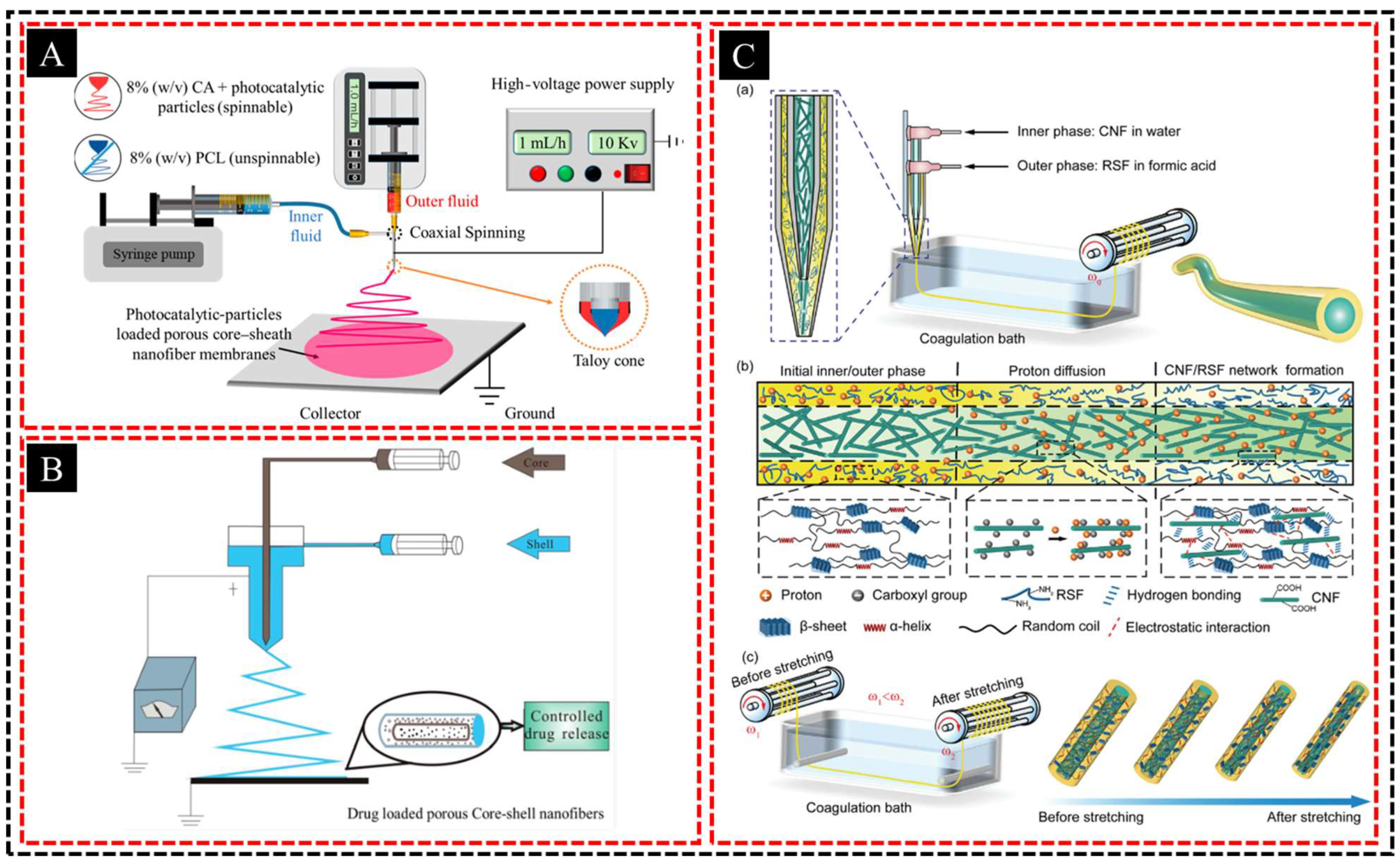
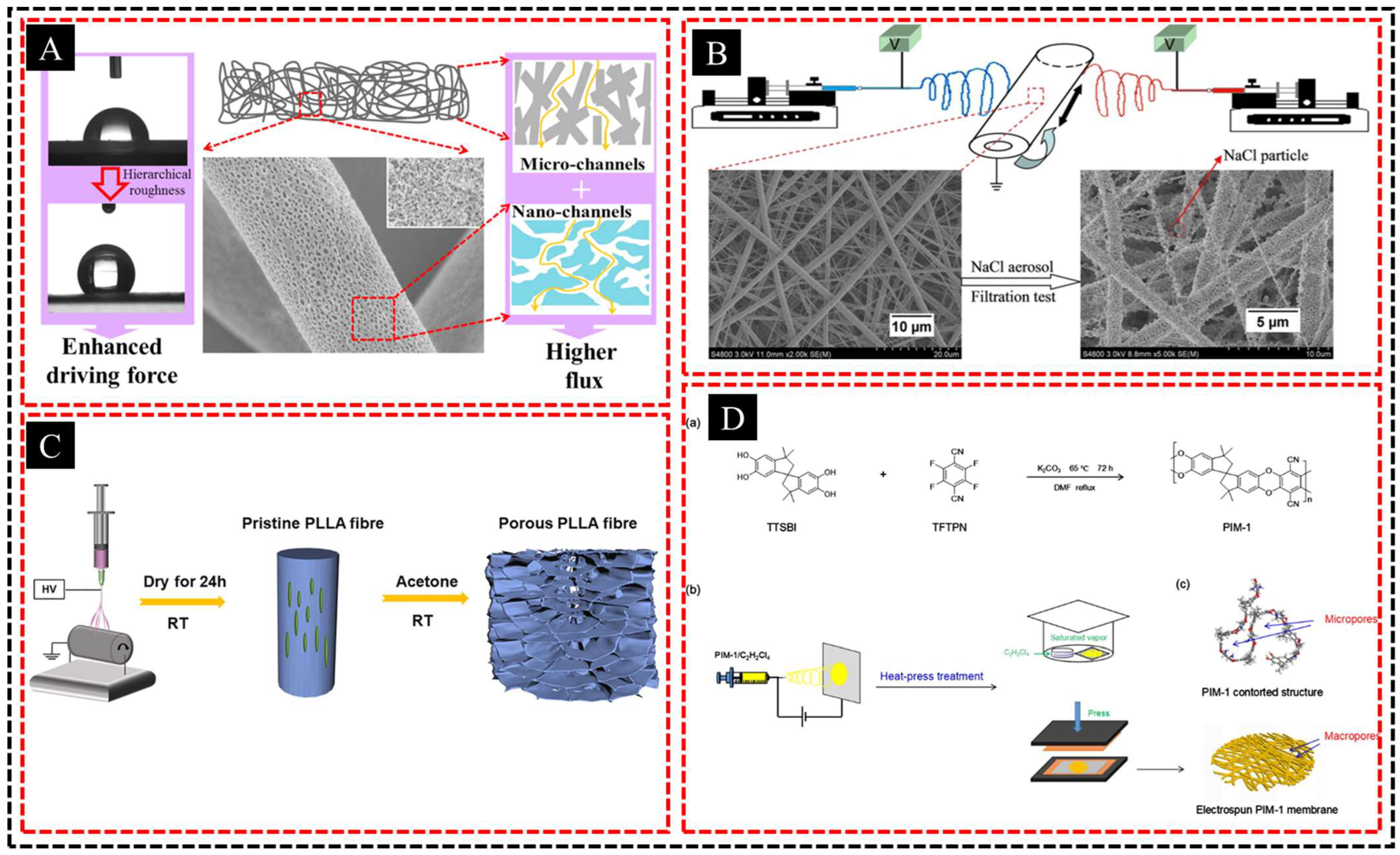

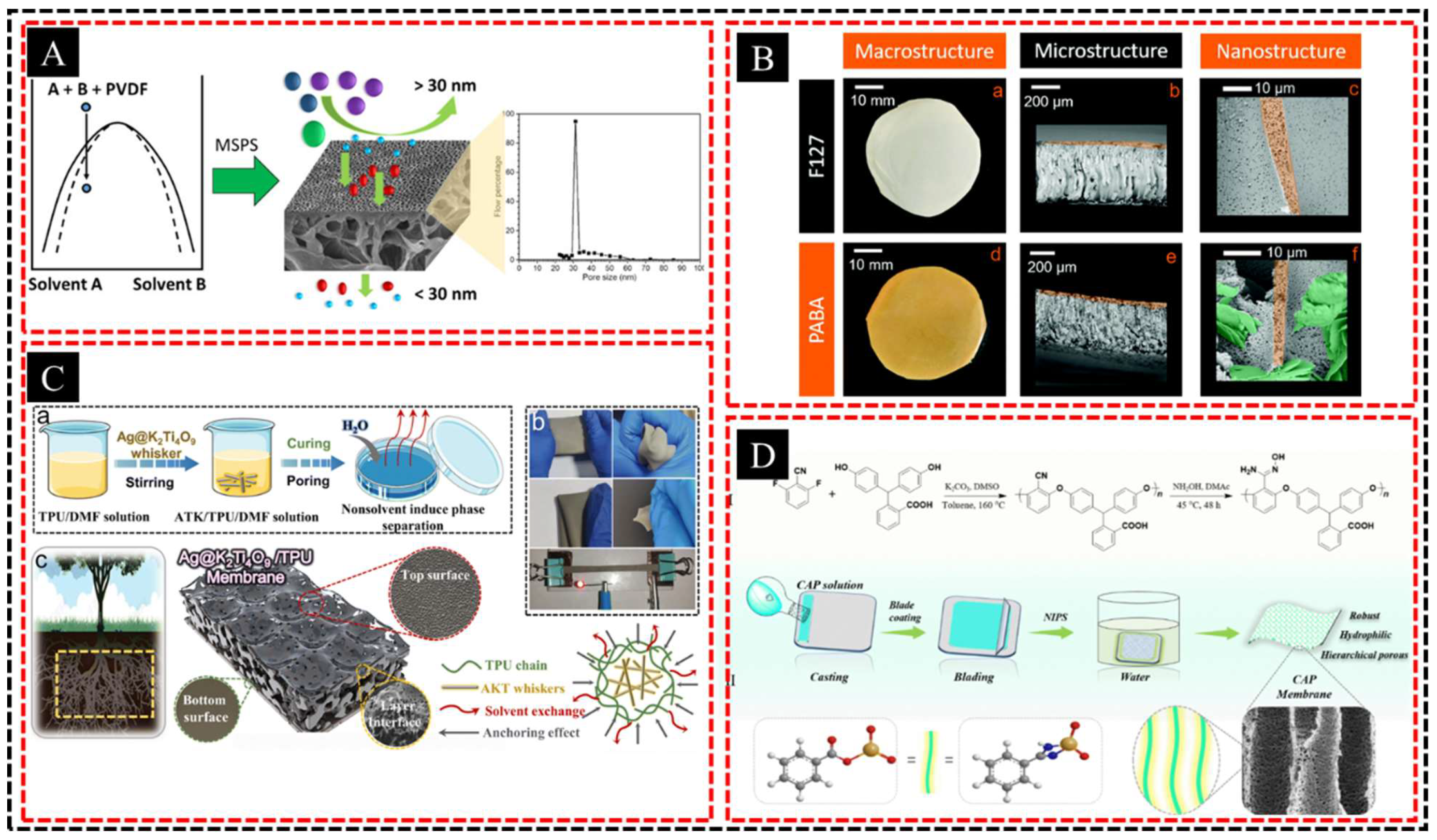
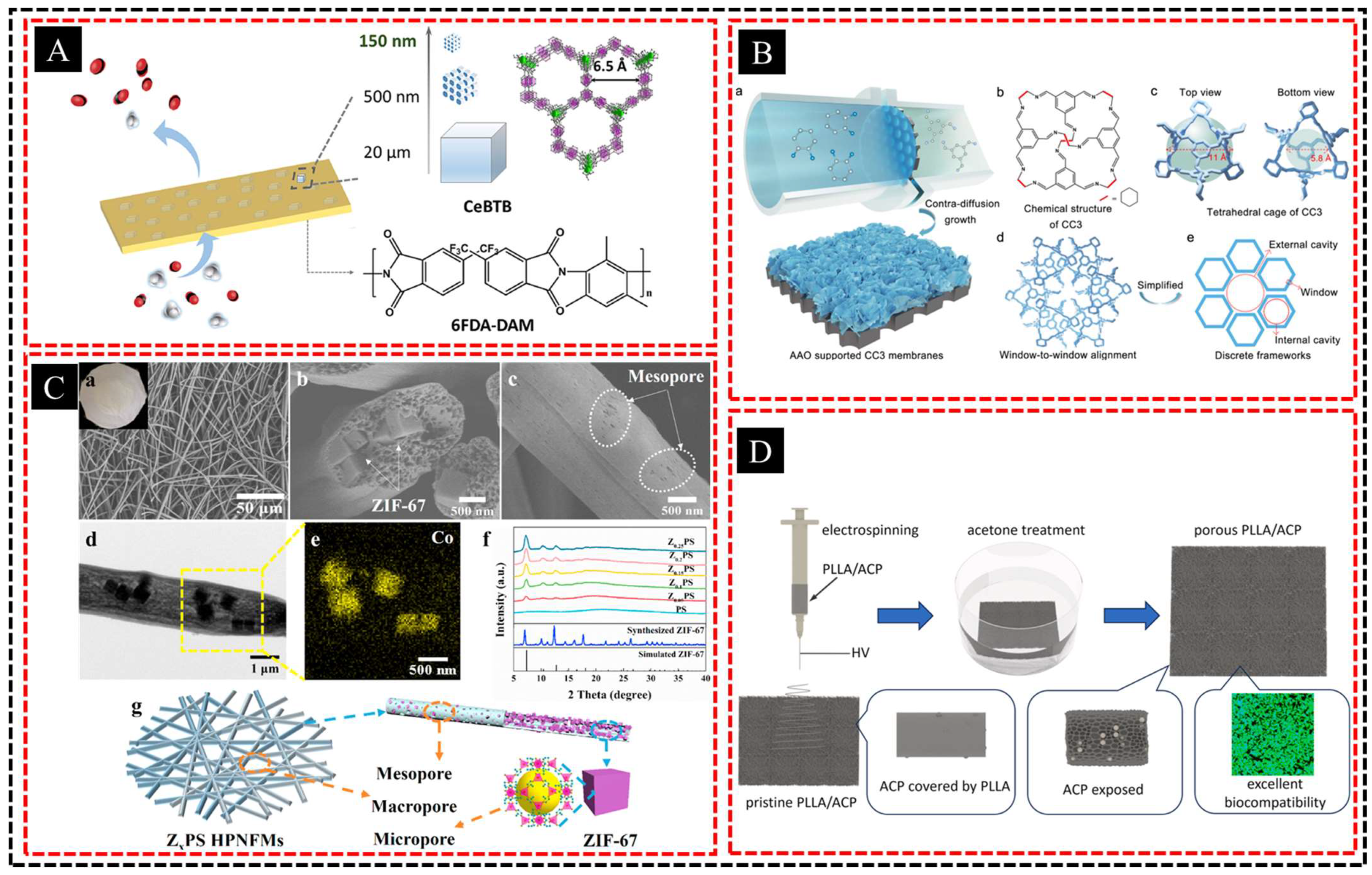



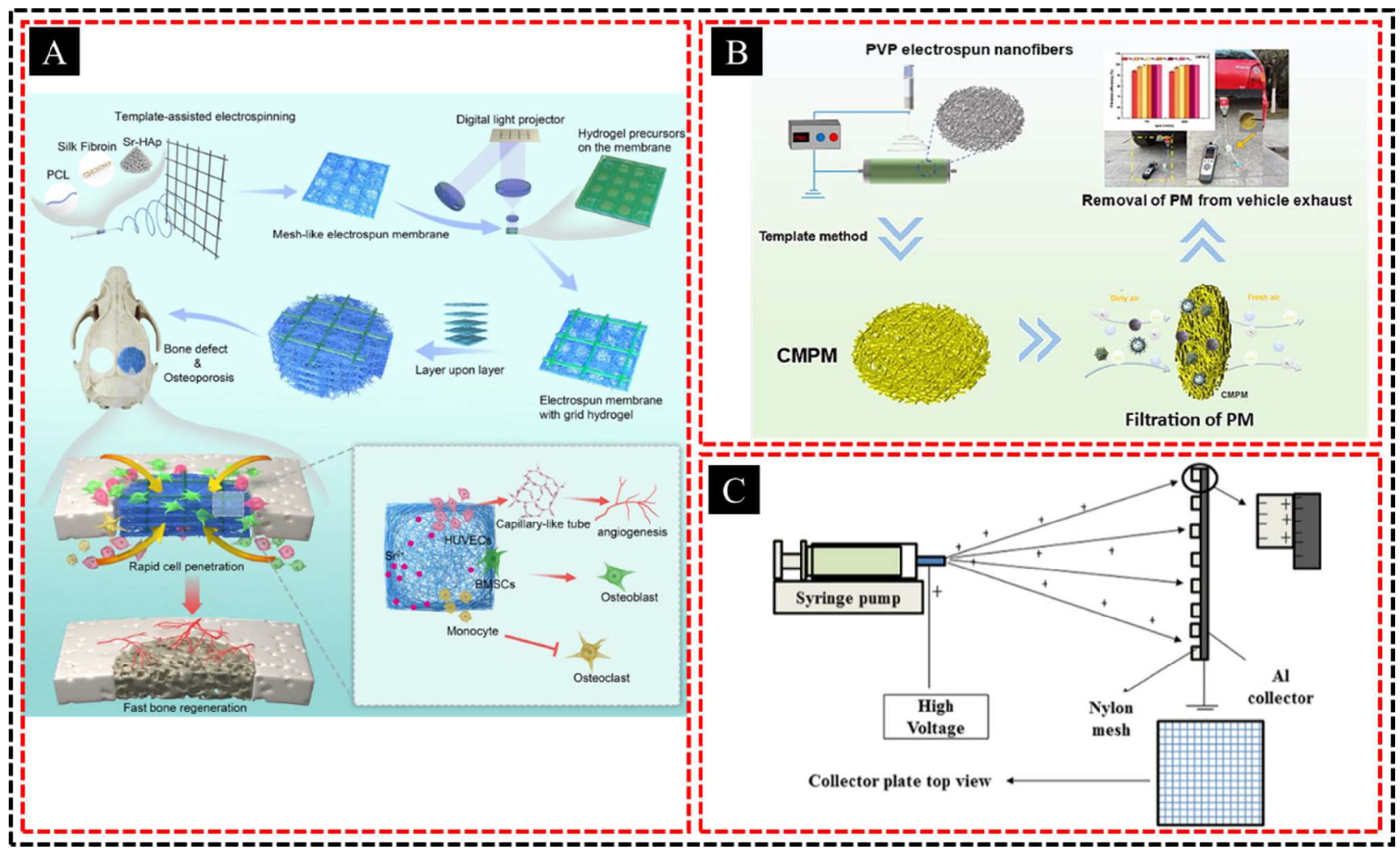


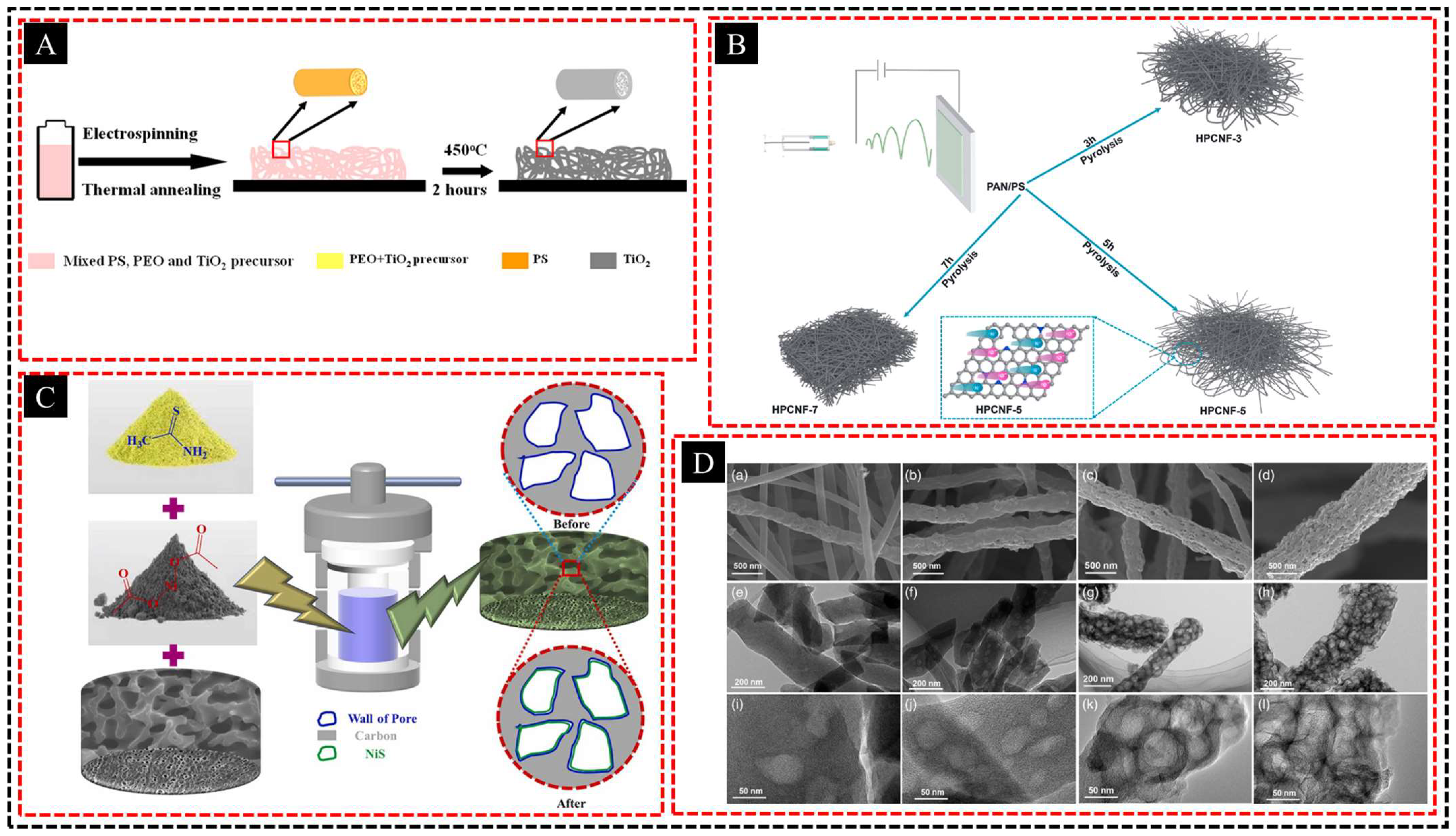
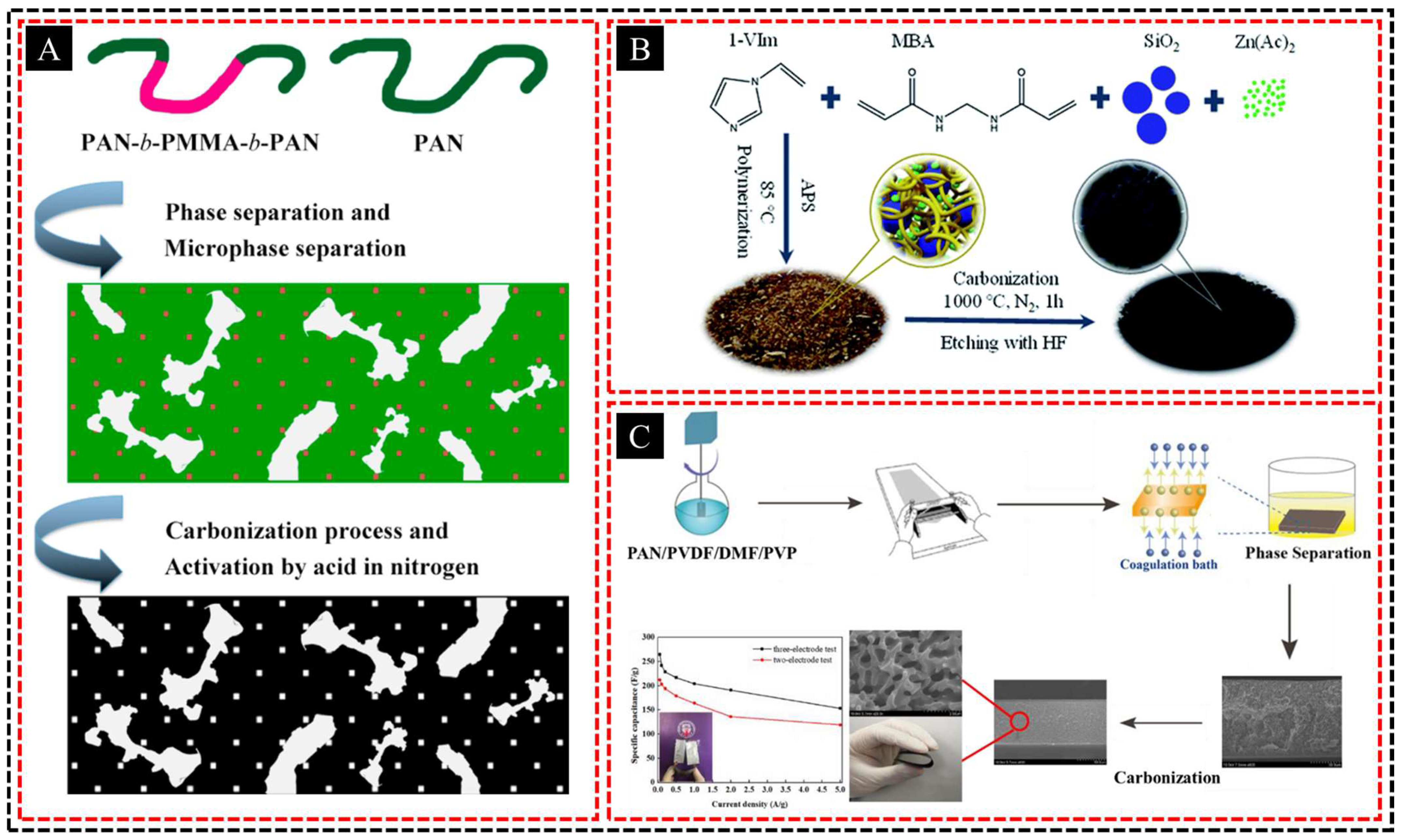

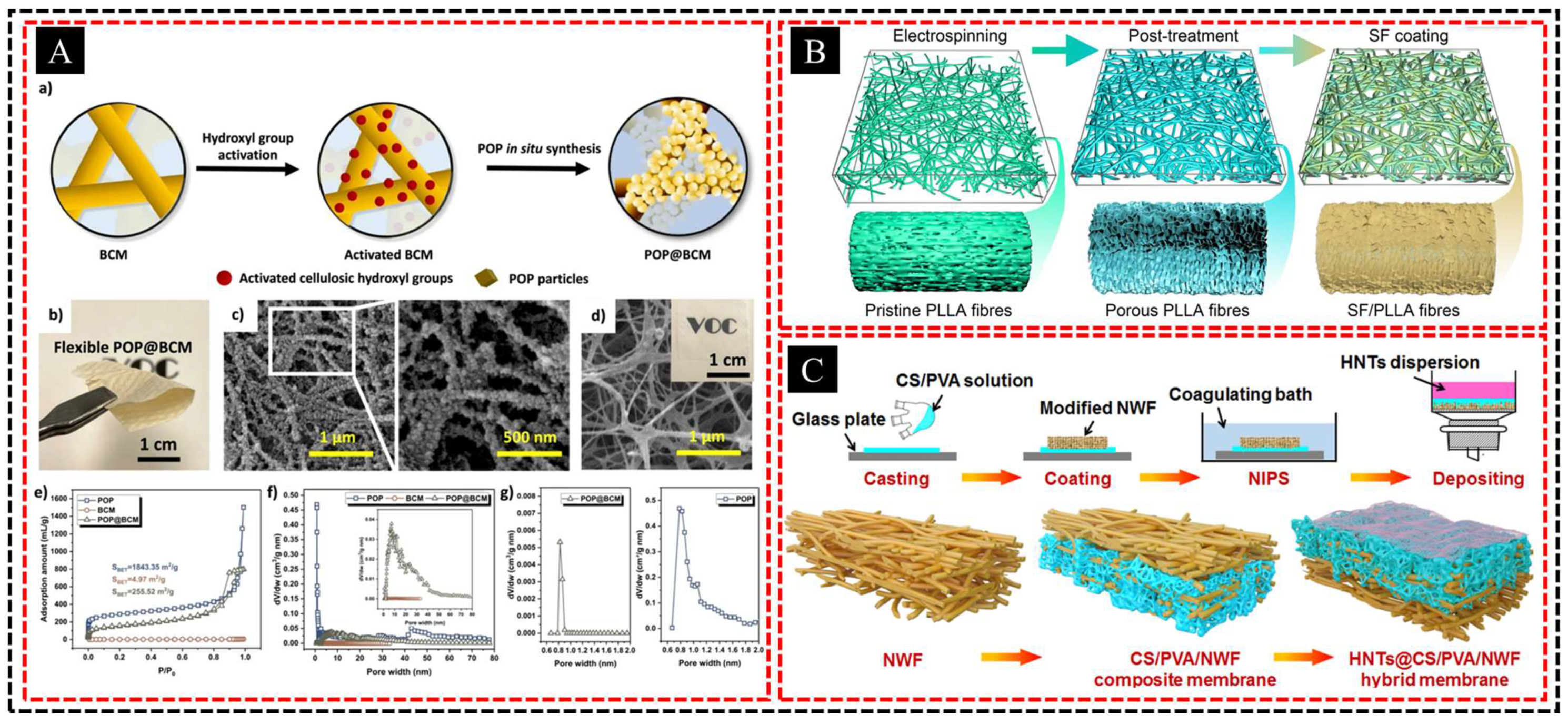
| Applications | Types | Pore Structures | Part |
|---|---|---|---|
| Batteries | PVP [101] | Micropores + mesopores + macropores | Electrode |
| SPEEK [102] | Macropores + mesopores | Electrolyte | |
| PAN [104] | Macropores + mesopores | Separator | |
| TPY-CNF + PVP/PAN [105] | Macropores + nanopores | Separator | |
| Poly (ionic liquid) [106] | Macropores + mesopores | Electrolyte | |
| Aramid nanofiber [107] | Microporous + nanopores | Separator | |
| PVDF [108] | Macropores + mesopores | Separator | |
| PAN [109] | Macropores + mesopores | Electrode | |
| PA6/PET/PA6 [110] | Macropores + macroscale pores | Separator | |
| PVDF/PMIA [111] | Macropores + mesopores | Separator | |
| PES [112] | Finger-like pores + nanoscale pores | Separator | |
| PANI/PI [129] | Micropores + nanopores | Separators | |
| Supercapacitors | PANI [98] | Microchannels + Macropores | Electrode |
| GDY/PVA [123] | micropore | Separator | |
| PAN-b-PMMA-b-PAN triblock copolymer [125] | Micropores + mesopores | Electrode | |
| Poly(1-vinylimidazole) [126] | Micropores + mesopores | Electrode | |
| PAN, PVDF, PVP [127] | Micropores + mesopores | Electrode | |
| PS-b-P2VP block copolymer [128] | Micropores + mesopores | Electrolyte |
Disclaimer/Publisher’s Note: The statements, opinions and data contained in all publications are solely those of the individual author(s) and contributor(s) and not of MDPI and/or the editor(s). MDPI and/or the editor(s) disclaim responsibility for any injury to people or property resulting from any ideas, methods, instructions or products referred to in the content. |
© 2024 by the authors. Licensee MDPI, Basel, Switzerland. This article is an open access article distributed under the terms and conditions of the Creative Commons Attribution (CC BY) license (https://creativecommons.org/licenses/by/4.0/).
Share and Cite
Cheng, X.; Bae, J. Recent Advancements in Fabrication, Separation, and Purification of Hierarchically Porous Polymer Membranes and Their Applications in Next-Generation Electrochemical Energy Storage Devices. Polymers 2024, 16, 3269. https://doi.org/10.3390/polym16233269
Cheng X, Bae J. Recent Advancements in Fabrication, Separation, and Purification of Hierarchically Porous Polymer Membranes and Their Applications in Next-Generation Electrochemical Energy Storage Devices. Polymers. 2024; 16(23):3269. https://doi.org/10.3390/polym16233269
Chicago/Turabian StyleCheng, Xiong, and Joonho Bae. 2024. "Recent Advancements in Fabrication, Separation, and Purification of Hierarchically Porous Polymer Membranes and Their Applications in Next-Generation Electrochemical Energy Storage Devices" Polymers 16, no. 23: 3269. https://doi.org/10.3390/polym16233269
APA StyleCheng, X., & Bae, J. (2024). Recent Advancements in Fabrication, Separation, and Purification of Hierarchically Porous Polymer Membranes and Their Applications in Next-Generation Electrochemical Energy Storage Devices. Polymers, 16(23), 3269. https://doi.org/10.3390/polym16233269








